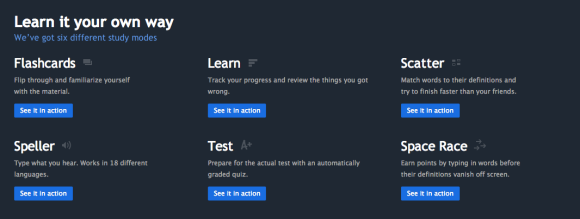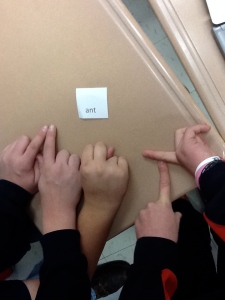 All students should be familiar with our nation’s founding documents, but the 18th-century writing style of these primary sources can be a difficult read for many students. Take for example The Declaration of Independence. While Thomas Jefferson’s masterpiece is only 1337 words, the content specific vocabulary (tyranny, usurpation) can be unfamiliar. One way to prepare students before or during reading is to use a free digital program called Word Sift which was designed to “help teachers manage the demands of vocabulary and academic language in their text materials.”
All students should be familiar with our nation’s founding documents, but the 18th-century writing style of these primary sources can be a difficult read for many students. Take for example The Declaration of Independence. While Thomas Jefferson’s masterpiece is only 1337 words, the content specific vocabulary (tyranny, usurpation) can be unfamiliar. One way to prepare students before or during reading is to use a free digital program called Word Sift which was designed to “help teachers manage the demands of vocabulary and academic language in their text materials.”
The entire text of the Declaration of Independence can be pasted onto a page on WordSift.org in order to quickly identify selected words that are repeated in the text. These words can appear alphabetically or as a word cloud:
 A WordSift.org word cloud of the Declaration of Independence (see above) visualizes how frequently Thomas Jefferson repeated words to emphasize or clarify an idea. While he used the word “people” ten times, the Word Sift program contextualized “people” as “person”, which clearly amplifies the focus on individual rights The next most frequent words highlighted words, “right” (ten times), “law” (nine times) and “power” (eight times), are part of the legal claim for the American colonies to separate from England. Teachers can prepare students for reading the Declaration of Independence by reviewing the vocabulary in advance and by showing the connection between a message and repeated language.
A WordSift.org word cloud of the Declaration of Independence (see above) visualizes how frequently Thomas Jefferson repeated words to emphasize or clarify an idea. While he used the word “people” ten times, the Word Sift program contextualized “people” as “person”, which clearly amplifies the focus on individual rights The next most frequent words highlighted words, “right” (ten times), “law” (nine times) and “power” (eight times), are part of the legal claim for the American colonies to separate from England. Teachers can prepare students for reading the Declaration of Independence by reviewing the vocabulary in advance and by showing the connection between a message and repeated language.
While word cloud programs are common on the Internet, theWordSift.org program offers a feature to identify and sort different lists of words according to academic discipline (math, science, ELA, and social studies). In addition, the words from any document can be sorted for English learners according to the New General Service List (NGSL). The words on the NGSL are most important high-frequency words of the English language, and knowing the 2800 words on the NGSL list will give more than 90% coverage for learners trying to read general texts of English.
A word sift of the Declaration of Independence identifies 57 words from the 2800 words of the NGSL (ex: injury, declare, purpose, circumstance). These words are highlighted in blue in the illustration below:
For all learners, anotherWordSift.org feature is an embedded Visual Thesaurus® with a limited image-search feature. TheWordSift.org site explains that the “most frequent word in the text is displayed under the Visual Thesaurus word web.” For example, a screenshot of the Visual Thesaurus illustration of the word “right” is below (NOTE: visualization of selected word is interactive only on the WordSift.org site):

The Visual Thesaurus can quickly show different meanings of the same word. The program also provides relevant examples from the selected text.
Once the students are introduced to the language of the Declaration, they could review the similarities between Jefferson’s structure and the five-paragraph essay. Most students are already familiar with this structure.
The introduction of the Declaration of Independence is 71 words, a paragraph of only one sentence, which addresses the audience (King George, colonists) and presents his purpose in a thesis of separation:
“… a decent respect to the opinions of mankind requires that they should declare the causes which impel them to the separation.”
The second section or Preamble is 272 words. This first body paragraph details Jefferson’s central claim about equal rights:
“We hold these truths to be self-evident, that all men are created equal, that they are endowed by their Creator with certain unalienable Rights, that among these are Life, Liberty and the pursuit of Happiness.”
The third section indicts King George III in a paragraph that lists the (27) complaints against the monarch. This extended list begins:
“The history of the present King of Great Britain is a history of repeated injuries and usurpations, all having in direct object the establishment of an absolute Tyranny over these States.”
The fourth section is a one paragraph accusation against the British people who did not respond to petitions for help from their American countrymen:
“Nor have We been wanting in attentions to our British brethren.”
The 159-word conclusion, the fifth section, restates the thesis: “…That these united Colonies are, and of Right ought to be Free and Independent States” and details the next steps (answering the “so what?”):
“…and that as Free and Independent States, they have full Power to levy War, conclude Peace, contract Alliances, establish Commerce, and to do all other Acts and Things which Independent States may of right do.”
As students review the organization of the Declaration of Independence, they can also consider the complexity of the sentence construction. There are nine colons, eight semicolons, and 98 commas, roughly one for every 13 words, that force the reader to stop and pause, to consider Jefferson’s lists and supporting details.
Using the program WordSift.org to introduce the vocabulary of any primary source document prepares students for reading and exploring the text independently. The creators of WordSift.org note:
We would be happy if you think of it playfully – as a toy in a linguistic playground that is available to instantly capture and display the vocabulary structure of texts, and to help create an opportunity to talk and explore the richness and wonders of language!
WordSift.org allows teachers to target instruction so that students understand 18th-century documents like the Declaration of Independence. This 21st-century tool helps students to explore “the richness and wonders of language” of our Founding Fathers in the document that made them citizens of the United States of America.




























